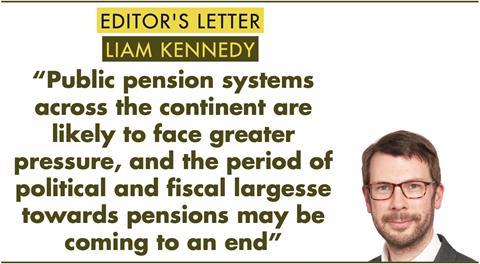Europe escaped the Great Retirement Boom but watch out for the crunch
Europe escaped the Great Retirement Boom but watch out for the ... IPE.com


The Importance of Sustainable Development Goals (SDGs) in Retirement Policies

In the UK, a recent report by Phoenix Group reveals that a million people in the retirement age group have left the workforce due to the pandemic.
Retirement Trends in Different Countries
A 2022 paper by the US Federal Reserve indicates that the retired share of the US population has increased by almost 1.5 percentage points compared to the pre-pandemic level, which accounts for most of the decline in the labor participation rate.
On the other hand, the European Union (EU) has experienced a satisfactory increase in labor market participation among individuals over the age of 55. Between 2005 and 2019, the proportion of economically active workers in the 55-64 age group increased by 21 percentage points, with a majority now employed. The proportion of workers aged over 55 increased from 12% to more than 20% during that period.
The EU expects this trend to continue, with the proportion of economically active individuals over 55 projected to reach around 72% by 2040. Policies such as France’s new pension reform, which promotes later retirement, are contributing to this increase. However, the protests that accompanied the passage of President Macron’s pension law highlight the strong attachment of some electorates to social and retirement entitlements.
Linking Retirement to Demography
Voter opposition to increasing retirement ages can be mitigated through transparent policies that link retirement to demography. Sweden’s decision to tie the retirement age to life expectancy has proven effective in strengthening the retirement system, according to the country’s Pension Agency. The Netherlands has also implemented a similar linkage, resulting in a slower rise in the retirement age as increases in life expectancy have slowed down.
Veronika Grimm, a member of Germany’s Council of Economic Experts, has proposed a more proportionate linkage between life expectancy and working life. Her suggestion is that individuals should only shoulder two-thirds of each year’s increases, meaning the retirement age would go up by eight months for every 12 months of increased life expectancy.
Challenges and Opportunities
The over-50s possess valuable skills and experience across various sectors, making their future participation in the labor force crucial not only for the sustainability of pension systems but also for Europe’s competitiveness.
However, a disproportionate number of blue-collar workers are medically unfit for work and more likely to support policies promoting early retirement. Fair policies should ensure social justice for those who have had physically demanding working lives. Some politicians in Denmark, Italy, Germany, and other countries have responded by implementing policies that exempt certain workers from working longer.
While the over-50s may be a politically engaged group whose votes are highly contested, it is important to recognize the significance of their skills. In Germany, concerns about a skills shortage, driven by the nation’s demographic challenges and pension policies, have been raised by Veronika Grimm and Germany’s Council of Economic Experts.
The Future of Public Pension Systems
With rising government borrowing costs and unfavorable demographics, public pension systems across Europe are likely to face increasing pressure. The era of political and fiscal generosity towards pensions may be coming to an end. Softening the impact of necessary policies will become more challenging.
If state pension systems are unable to afford the same level of benefits as before, the role of supplementary pensions becomes more important. It is crucial to make progress in the second pillar of retirement savings across Europe.
Progress in Retirement Savings
Germany has made little progress in facilitating defined contribution pension schemes, despite policy efforts. The current mix of second and third-pillar schemes and incentives needs to be streamlined. In France, there has been clearer progress and a restructuring of pillar-two and three savings schemes, with assets expected to exceed €200bn by 2024.
However, the risk appetite of European retirement savers remains uncertain. European savers tend to be conservative and are unlikely to embrace risk in the same way as workers in the US or the UK. Policymakers are slowly recognizing the benefits of funded pensions but should not expect a sudden inflow of pension assets into equities.
Liam Kennedy, Editor
liam.kennedy@ipe.com
SDGs, Targets, and Indicators
1. Which SDGs are addressed or connected to the issues highlighted in the article?
- SDG 8: Decent Work and Economic Growth
- SDG 10: Reduced Inequalities
- SDG 12: Responsible Consumption and Production
The article discusses the impact of retirement and pension policies on the labor force, economic growth, and social equality. These issues are directly connected to SDG 8, which aims to promote sustained, inclusive, and sustainable economic growth, full and productive employment, and decent work for all. It is also connected to SDG 10, which aims to reduce inequalities within and among countries. Additionally, the article touches upon responsible consumption and production, which is a key aspect of SDG 12.
2. What specific targets under those SDGs can be identified based on the article’s content?
- Target 8.5: By 2030, achieve full and productive employment and decent work for all women and men, including for young people and persons with disabilities.
- Target 10.4: Adopt policies, especially fiscal, wage, and social protection policies, and progressively achieve greater equality.
- Target 12.8: By 2030, ensure that people everywhere have the relevant information and awareness for sustainable development and lifestyles in harmony with nature.
The article highlights the need for policies that promote full and productive employment for all age groups (Target 8.5). It also discusses the importance of adopting policies that reduce inequalities, particularly in retirement and pension systems (Target 10.4). Furthermore, it emphasizes the need for awareness and information on sustainable retirement savings and consumption (Target 12.8).
3. Are there any indicators mentioned or implied in the article that can be used to measure progress towards the identified targets?
- Labour market participation rate
- Proportion of economically active workers in the 55-64 age group
- Proportion of workers aged over 55
- Retirement age
- Life expectancy
- Skills shortage
- Take-up of defined contribution pension schemes
- Assets in second and third-pillar pension schemes
- Risk appetite of retirement savers
The article mentions several indicators that can be used to measure progress towards the identified targets. These include labor market participation rates, the proportion of economically active workers in specific age groups, retirement age, life expectancy, skills shortage, take-up of defined contribution pension schemes, assets in second and third-pillar pension schemes, and the risk appetite of retirement savers.
SDGs, Targets, and Indicators
| SDGs | Targets | Indicators |
|---|---|---|
| SDG 8: Decent Work and Economic Growth | Target 8.5: By 2030, achieve full and productive employment and decent work for all women and men, including for young people and persons with disabilities. | – Labour market participation rate – Proportion of economically active workers in the 55-64 age group – Proportion of workers aged over 55 |
| SDG 10: Reduced Inequalities | Target 10.4: Adopt policies, especially fiscal, wage, and social protection policies, and progressively achieve greater equality. | – Retirement age – Life expectancy – Skills shortage |
| SDG 12: Responsible Consumption and Production | Target 12.8: By 2030, ensure that people everywhere have the relevant information and awareness for sustainable development and lifestyles in harmony with nature. | – Take-up of defined contribution pension schemes – Assets in second and third-pillar pension schemes – Risk appetite of retirement savers |
Behold! This splendid article springs forth from the wellspring of knowledge, shaped by a wondrous proprietary AI technology that delved into a vast ocean of data, illuminating the path towards the Sustainable Development Goals. Remember that all rights are reserved by SDG Investors LLC, empowering us to champion progress together.
Source: ipe.com

Join us, as fellow seekers of change, on a transformative journey at https://sdgtalks.ai/welcome, where you can become a member and actively contribute to shaping a brighter future.







